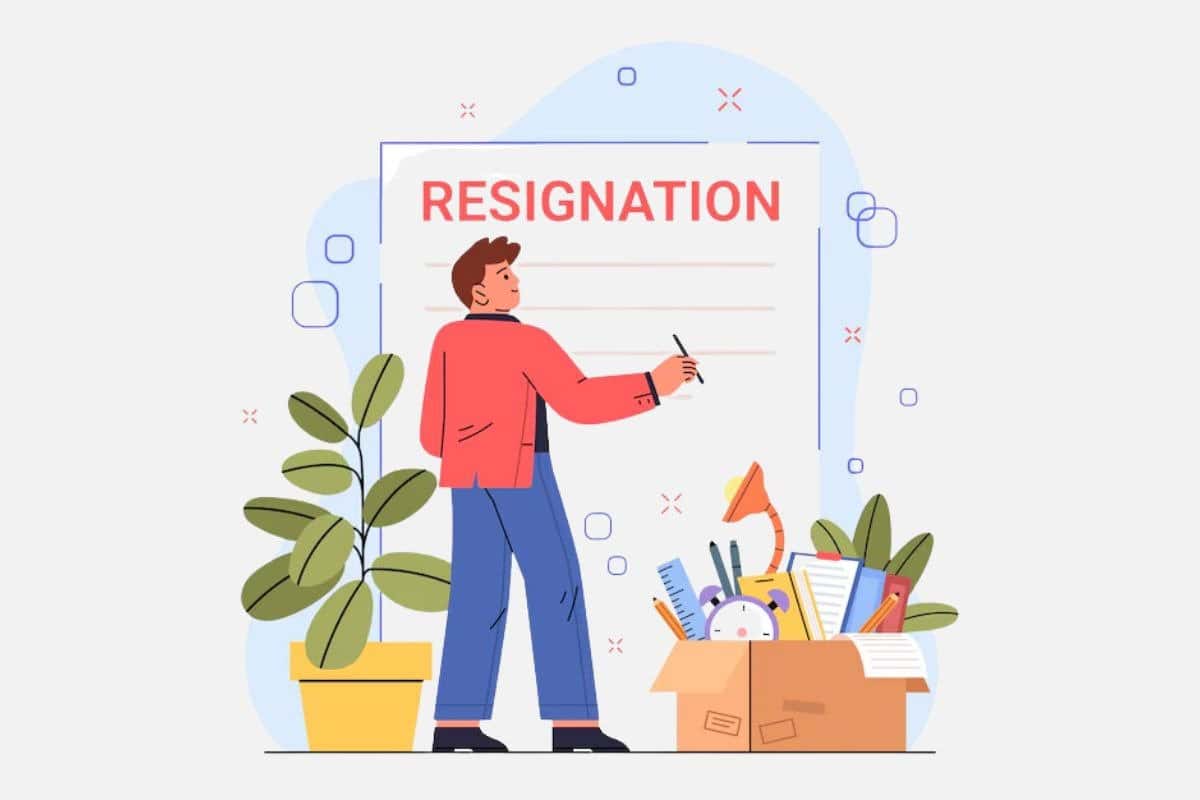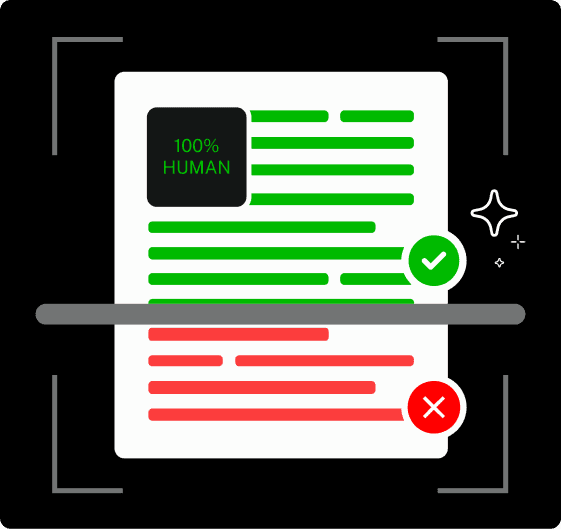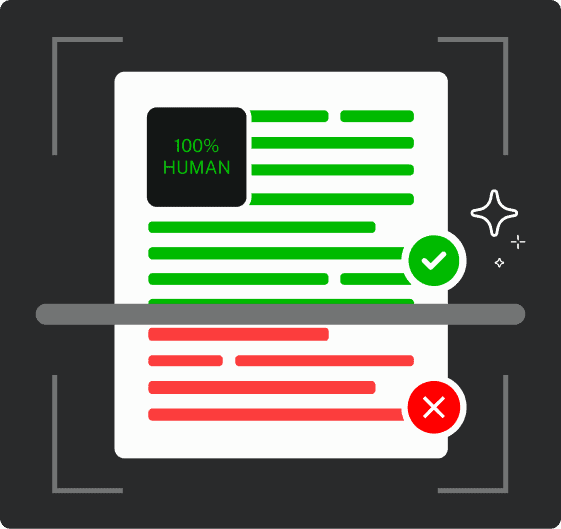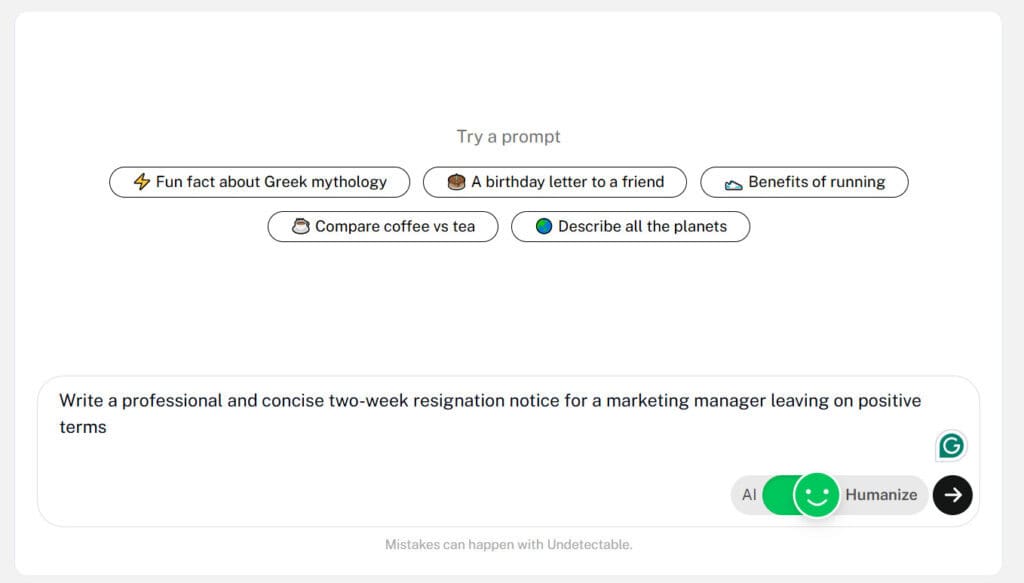Quitting a job is, without a doubt, nerve-wracking.
You’re probably juggling mixed emotions, excitement about your next chapter, and a touch of anxiety about how to break the news without burning bridges.
The way you announce your departure shapes your professional reputation.
I know, I know, you may be wondering, “Do I really need to bother writing a two week notice?”
The short answer is yes, absolutely. You really don’t want to skip it.
In this guide, I’ll break down the exact process step-by-step on how to write a two week notice with practical tips and examples.
Let’s get it done right.
What Is a Two-Week Notice?
A two-week notice is a formal way of telling your employer,
“Hey, I’m moving on to bigger and better things in two weeks.”
It’s essentially your resignation letter with a polite timer attached.
Never Worry About AI Detecting Your Texts Again. Undetectable AI Can Help You:
- Make your AI assisted writing appear human-like.
- Bypass all major AI detection tools with just one click.
- Use AI safely and confidently in school and work.
The notice gives your employer time to delegate your responsibilities and find someone to replace you (or at least brace for the transition).
It’s usually in writing, though some conversations start face-to-face before putting pen to paper.
The two weeks notice is long enough for companies to shuffle around their workflow without chaos but short enough to keep things from getting awkward if there’s bad blood.
Why Giving Proper Notice Is Important?
You may think, Why should I care about the two week notice? I’m leaving anyway.
But a two week notice is important for the following reasons:
- Maintaining professional relationships: Most industries are surprisingly small. Ghosting your job or leaving without notice can come back to haunt you in the form of bad references or awkward future encounters.
- Your reputation: Professionalism isn’t just for show. It defines how people remember you. Exiting gracefully by giving two weeks’ notice lets others know you take commitments seriously.
- Easing team transition: When you leave your responsibilities suddenly, your team has to pick up the pieces. A well-planned exit helps them stay afloat and leaves a positive final impression of your work ethic.
When You Should (and Shouldn’t) Give Two Weeks’ Notice?
A two week notice is a professional courtesy that helps you leave on good terms.
Based on your employment terms, it may be a necessary step in the formal resignation process.
In some cases, you are permitted to use your vacation days to cover the notice period and depart right away.
However, there are times when giving two weeks’ notice isn’t necessary or even advisable.
For instance, if your work environment is toxic or unsafe, you shouldn’t feel obligated to stay longer than absolutely necessary.
Your mental and physical well-being take priority over professional etiquette.
Similarly, in certain industries or companies, employees who resign are escorted out immediately, which makes the idea of a two-week transition irrelevant.
If you suspect this might happen, it’s wise to be discreet and time your notice after preparing for a potential early exit.
How to Write a Two-Week Notice Step by Step
The two week notice, when done right, keeps your doors open and preserves your work relationships.
Here’s exactly how to write up a two week notice.
Step 1: Plan Your Resignation Timing
When you resign shouldn’t just be a date on a calendar.
You don’t want to walk out mid-project or during a staffing crisis.
Timing your resignation thoughtfully with respect to the company can prevent your departure from being seen as selfish or disruptive.
Of course, it doesn’t mean putting your life on hold indefinitely, but a little courtesy goes a long way.
Also, align it with your next steps.
If starting a new role, ensure your start date gives you enough time to wrap things up at your current role without causing financial headaches.
Once you’ve nailed down your timing, plan how you’ll break the news.
Spoiler alert: Springing your resignation in a random meeting is a bad idea. Be intentional about it.
Step 2: Keep It Professional and Concise
The purpose of a resignation letter is simple: inform, thank, and offer a transition plan.
Keep it short and straightforward, yet respectful.
Even if you’ve had a rocky time, avoid emotional overtones since you’re writing for the company’s records.
Be wary of including unnecessary details.
Your employer doesn’t need to know your reasons unless you’re comfortable sharing them in person.
If you’re leaving for a better opportunity, there’s no need to overshare about your new job.
You can whip up a professional letter using AI like our AI Chat feature using the following prompt:
“Write a professional and concise two week resignation notice for a [Your Position, e.g., marketing manager] leaving on positive terms.”
Step 3: Express Gratitude and Appreciation
Whether you loved your job or couldn’t wait to leave, acknowledging the positive aspects of your experience shows your professionalism.
It also maintains strong relationships with your soon-to-be former colleagues and supervisors.
Gratitude can take many forms.
Think about the skills or experience you gained that will help your career long-term or someone who mentored or supported you along the way.
Acknowledge those positives in your two week notice letter.
A brief, sincere acknowledgment of the experience and opportunities you’ve had is enough to leave a positive mark.
Step 4: Offer a Smooth Transition Plan
Your resignation is already an inconvenience to the company you’re leaving, so the more you can do to ease the burden, the better.
Plus, a well-thought-out transition plan also adds to your professional conduct.
Here is how to write a two week notice email with a solid transition plan:
- Project handovers: Outline which tasks you’ll complete before your departure and what needs to be passed on.
- Training support: Offer to train a replacement or create documentation for your responsibilities.
- Availability: Let them know if you’re open to helping out remotely after you leave (only if you mean it, though).
Step 5: Avoid Negative Comments or Complaints
You’re probably thinking, “But what if I’ve got a LOT to say about my time here?”
Sure, you may have a few things to vent about that micromanaging boss and office politics but don’t do it in your resignation letter.
There’s no benefit to burning bridges, no matter how tempting it might be at the moment. Even if you’re leaving because of toxic conditions, make your letter neutral.
Keep your complaints for trusted friends over drinks.
Maintain your cool. Stay classy. You want your final impression to be one of professionalism, not pettiness.
Step 6: Deliver Your Notice in the Best Way
How you deliver your notice matters almost as much as what you write. Be direct and respectful.
Ideally, have a face-to-face conversation with your manager or a video call if you’re remote.
Here’s how to write a two week notice letter and deliver it in the best way possible:
- Set up a meeting: “Hey [Manager’s Name], can we schedule a short meeting? I’d like to discuss something important.”
- Break the news professionally: “Thanks for meeting with me. I wanted to let you know that I’ve decided to resign from my position. My last working day will be [insert date].”
- Follow up with your formal two-week notice: After the conversation, email your resignation letter to HR and your manager. It’s official now, and both parties have a written record.
Two-Week Notice Template and Examples
There are a million different ways to announce your exit from a company.
Below are some of the most commonly used templates.
1. Simple Two-Week Notice Template
This template works best for most situations.
[Your Name]
[Your Address (optional)]
[City, State, Zip Code]
[Email Address]
[Date]
[Manager’s Name]
[Company Name]
[Company Address] (optional)
Dear [Manager’s Name],
I am writing to formally notify you of my resignation from my position as [Job Title] at [Company Name]. My last day of work will be [last working day, two weeks from today].
I want to express my sincere gratitude for the opportunity to be a part of the [Company Name] team. My time here has been invaluable, and I appreciate the support and guidance I’ve received.
During the next two weeks, I am committed to ensuring a smooth transition. I will complete my current projects and provide any assistance needed to train my replacement or transfer responsibilities.
Please let me know how I can help further during this transition period. Thank you again for the opportunity, and I wish the company continued success.
Sincerely,
[Your Name]
2. Formal Two-Week Notice Example
The following example is best for a role that requires a more polished tone, especially in corporate or highly structured environments.
[Your Name]
[Your Position]
[Department (optional)]
[Date]
[Manager’s Name]
[Manager’s Title]
[Company Name]
Dear [Manager’s Name],
I am writing to formally resign from my position as [Job Title] with [Company Name], effective [last working day, two weeks from today].
I am deeply grateful for the opportunities I have had to grow and develop professionally during my tenure with the company. Working under your leadership and alongside such talented colleagues has been an enriching experience. I am proud of what we accomplished together and will carry those achievements forward in my career.
In order to facilitate a smooth transition, I will ensure that key responsibilities are documented and ongoing projects are either completed or appropriately delegated. I am happy to assist in training a replacement and to provide any other support necessary to minimize disruption.
Thank you once again for your guidance and support. I look forward to staying in touch, and I wish [Company Name] continued success.
Sincerely,
[Your Name]
[Contact Information (optional)]
3. Short and Direct Two-Week Notice Example
If you’re looking to keep things brief, this version delivers the message quickly without sacrificing professionalism.
It’s great for situations where you need to get straight to the point or if you’re on friendly terms with your manager.
[Date]
Dear [Manager’s Name],
Please accept this letter as my formal notice of resignation from my position as [Job Title] at [Company Name]. My final day of work will be [last working day, two weeks from today].
I want to thank you for the opportunity to be part of the team. My experience here has been valuable, and I am committed to ensuring a smooth transition during the next two weeks.
Thank you for your understanding and support.
Sincerely,
[Your Name]
Email vs. Printed Resignation: Which One to Use?
Now that your two week notice is ready, you’re probably wondering: Should I send it via email or hand in a printed copy?
Let’s talk about printed resignation letters first.
If you work in a formal, traditional environment like law firms, corporate offices, or government agencies, handing over a printed letter is still considered a sign of respect.
If you’re in a remote-first or tech-driven company, email is the way to go. It’s quick, efficient, and leaves a formal digital trail.
You can send it from anywhere and know that your resignation is documented with a timestamp, which is very helpful if your manager is often travelling or works across time zones.
In most cases, a hybrid approach works best, schedule a meeting with your manager to resign in person, then follow up with an email for documentation.
How AI Can Help You Write a Perfect Two-Week Notice?
Writing a two week notice isn’t exactly the most exciting task. Plus, not everyone is a natural wordsmith.
You can use Undetectable AI to make your life easier when planning your career move.
Here’s how it helps:
- AI can create you an initial draft that serves as a solid structure to work with, particularly if you’re in a time crunch.
- You can explore different drafts with various types of tone to find the one that best fits your workplace culture.
- If you’re worried about coming off the wrong way, especially if you’re emotional about leaving, AI can provide you with a neutral draft.
- AI checks for grammar and formatting mistakes to ensure your letter looks polished.
Pro Tip: If you’re including images in your resignation letter or farewell email, make sure they’re high-quality and authentic. Tools like AI Image Detector can help verify whether an image is AI-generated or not—so your message stays polished and professional.
Test both our AI Detector and Humanizer in the widget below!
Conclusion
Your two weeks notice should balance brevity with sincerity.
Outline key details, resignation, last day, gratitude, and a willingness to support the transition.
Thoughtful planning of your exit will leave your employer in a good position and reflect positively on your own professionalism.
If you’re unsure how to write a two week notice, Undetectable AI Chat can help you get started with ready-to-edit drafts in different styles.
You can customize your tone, for example, a formal version for a corporate role or a more direct and conversational one for a startup and then fill it in with your details.
Give Undetectable AI a try today!




